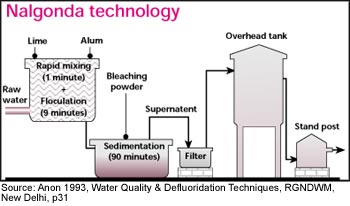Wahtech
 The official attitude towards fluoride-laced groundwater is best seen in the manner the state has gone about solutions.
The official attitude towards fluoride-laced groundwater is best seen in the manner the state has gone about solutions.
In a 1999 nationwide study New Delhi-based Fluorosis Research and Rural Development Foundation (frrdf) found that "only a few laboratories in the country have specified the methodology for fluoride analysis.' Experts claim the ion selective electrode method is the most sensitive. But all over India, only 117 laboratories possess this facility. "Water quality testing has not got much importance. Right now the thrust is on water supply coverage. Money has been provided to set up laboratories with the best testing facilities, but some states have not taken an action,' says Alok.
frrdf's 1999 report also points out that most states follow different methods. There are no specified equipments which are to be used while testing fluoride. Ideally, every water source in an endemic region needs to be tested: fluoride is unevenly distributed in groundwater, both horizontally and vertically. But, "We have carried out stratified sampling (5-10 per cent samples) of water, as testing 100 per cent sources is very expensive. If samples are contaminated, then we go for 100 per cent sampling in affected blocks,' says Alok. So it is common that once handpumps are dug, they spew poisoned water. "Digging of tubewells in India is not always a technical decisions. It is a political decision. Most state government's are not regularly monitoring groundwater,' says Gupta.
Once fluoride is detected in water, the obvious step is to defluoridate water. The technology to be adopted depends upon the fluoride levels in water and the volume of water to be defluoridated. In India various technologies have been tested (see table: Technologies available for defluoridation). But none are fool-proof. "Ion exchange and chemical treatments are cost intensive, while physical methods suffer limitations, like frequent change in defluoridant beds and the inability to reduce fluoride to non-toxic levels,' points out a Current Science paper. "Defluoridation plants and household water treatment kits are stop-gap solutions,' says Arun Mudgirkar, project officer, unicef, Gandhinagar, Gujarat. He is right; but it is also true that clean-up schemes
